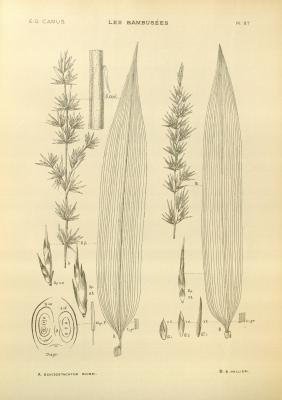Schizostachyum blumei
Nees
Poaceae
Arundarbor longinodes (Miq.) Kuntze
Arundo spiculorum Oken
Bambusa longinodis Miq.
Melocanna longispiculata Kurz ex Teijsm. & Binn.
Melocanna tenuispiculata Kurz ex Teijsm. & Binn.
Melocanna zollingeri longispiculata Munro
Schizostachyum longispiculatum (Munro) Kurz
Schizostachyum zollingeri longispiculatu (Munro) E.G.Camus
Common Name:
General Information
Schizostachyum blumei is an evergreen bamboo producing a dense clump of culms 3 - 7 metres tall from short, woody rhizomes. The thin-walled, woody culms can be erect or arching, with a pendulous tip; they are 10 - 20mm in diameter with internodes 30 - 60cm long[
310- Title
- Plant Resources of Southeast Asia
- Publication
-
- Author
-
- Website
- http://proseanet.org/
- Publisher
-
- Year
- 0
- ISBN
-
- Description
- Lots of information on the uses of the plants of SE Asia.
].
The culms are often harvested from the wild for their range of uses. They are traded in local markets and the plant is occasionally cultivated[
310- Title
- Plant Resources of Southeast Asia
- Publication
-
- Author
-
- Website
- http://proseanet.org/
- Publisher
-
- Year
- 0
- ISBN
-
- Description
- Lots of information on the uses of the plants of SE Asia.
].
Known Hazards
None known
Botanical References
Range
E. Asia - Myanmar, Vietnam, Malaysia, Indonesia.
Habitat
Lowland forest, often along rivers and in hill dipterocarp forest; forest margins and in lowland wasteland along roads; at elevations up to 800 metres[
310- Title
- Plant Resources of Southeast Asia
- Publication
-
- Author
-
- Website
- http://proseanet.org/
- Publisher
-
- Year
- 0
- ISBN
-
- Description
- Lots of information on the uses of the plants of SE Asia.
].
Properties
| Other Uses Rating |      |
| Habit | Evergreen Bamboo |
| Height | 5.00 m |
| Pollinators | Wind |
| Cultivation Status | Wild |
Cultivation Details
Young shoots are produced continuously in a mature clump. At first a young shoot is erect, up to about 2 m tall, and later the upper part becomes pendulous. When leafy branches develop, the culm cannot support itself and flops over older culms. In the field a clump of Schizostachyum blumei looks like a compact bush, with old culms flopping over and young shoots sticking up above the old culms.|Flowers can be found all the year round, but fruits are rare[
310- Title
- Plant Resources of Southeast Asia
- Publication
-
- Author
-
- Website
- http://proseanet.org/
- Publisher
-
- Year
- 0
- ISBN
-
- Description
- Lots of information on the uses of the plants of SE Asia.
].
Bamboos have an interesting method of growth. Each plant produces a number of new stems annually - these stems grow to their maximum height in their first year of growth, subsequent growth in the stem being limited to the production of new side branches and leaves. In the case of some mature tropical species the new stem could be as much as 30 metres tall, with daily increases in height of 30cm or more during their peak growth time. This makes them some of the fastest-growing species in the world[
K- Title
- Plants for a Future
- Author
- Ken Fern
- Description
- Notes from observations, tasting etc at Plants For A Future and on field trips.
].
Bamboos in general are usually monocarpic, living for many years before flowering, then flowering and seeding profusely for a period of 1 - 3 years before usually dying.
Edible Uses
None known
Medicinal
None known
Other Uses
The long slender culms are used for making fishing rods and traditional flutes[
310- Title
- Plant Resources of Southeast Asia
- Publication
-
- Author
-
- Website
- http://proseanet.org/
- Publisher
-
- Year
- 0
- ISBN
-
- Description
- Lots of information on the uses of the plants of SE Asia.
].
Propagation
Seed -
If you have any useful information about this plant, please leave a comment. Comments have to be approved before they are shown here.


 Useful Tropical Plants Database 2014 by
Ken Fern,
web interface by
Ajna Fern
with help from
Richard Morris.
Useful Tropical Plants Database 2014 by
Ken Fern,
web interface by
Ajna Fern
with help from
Richard Morris.